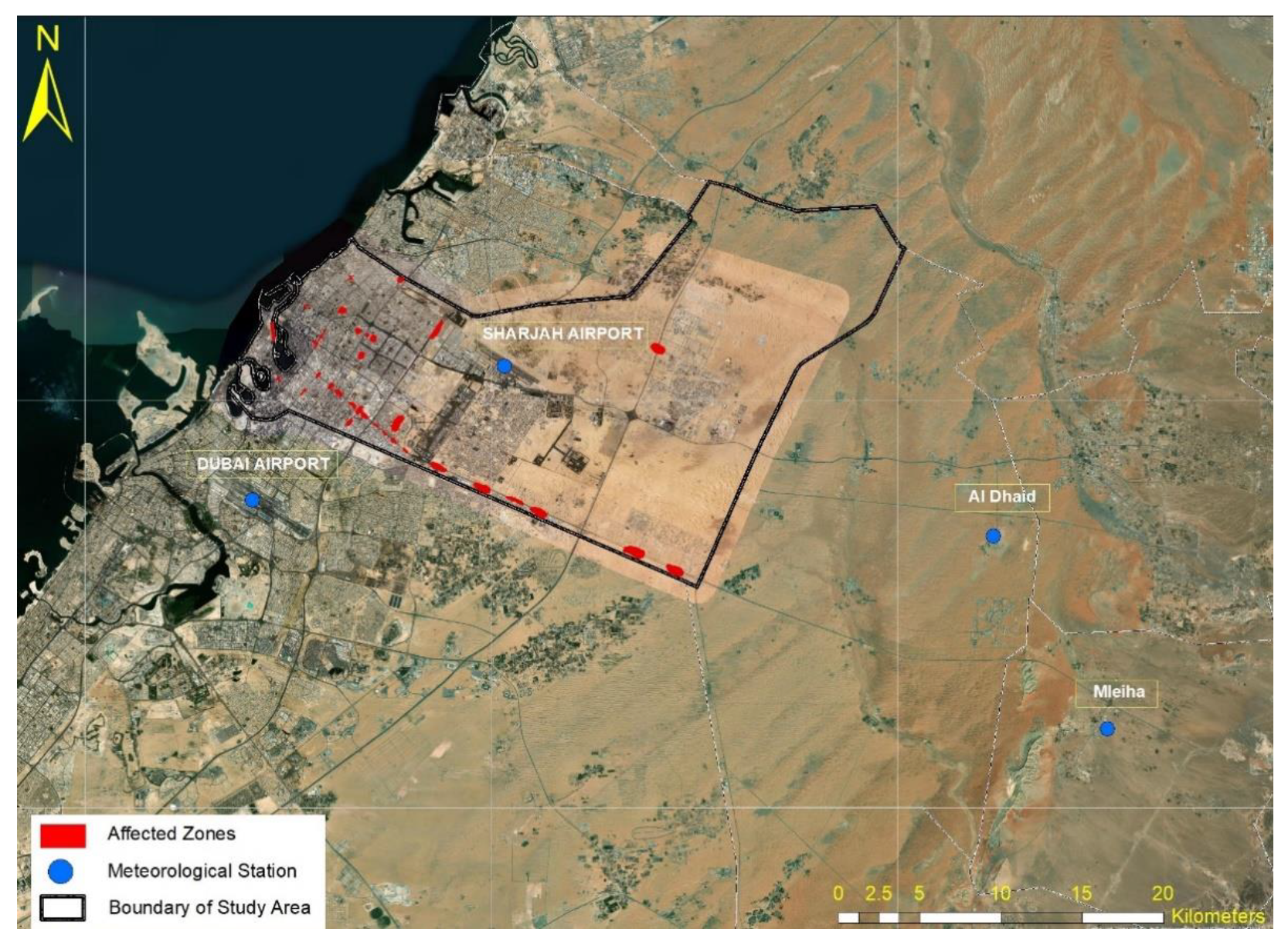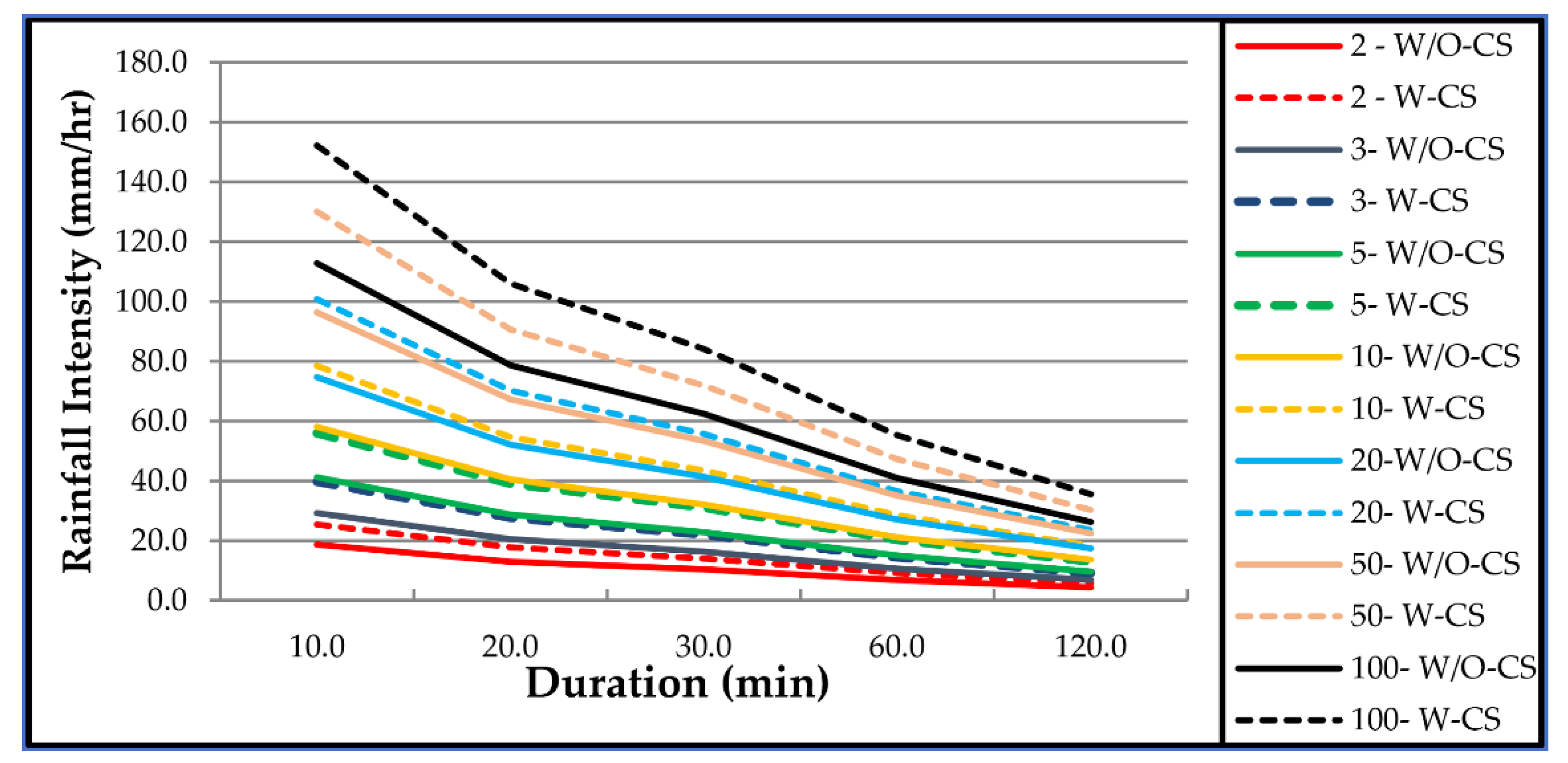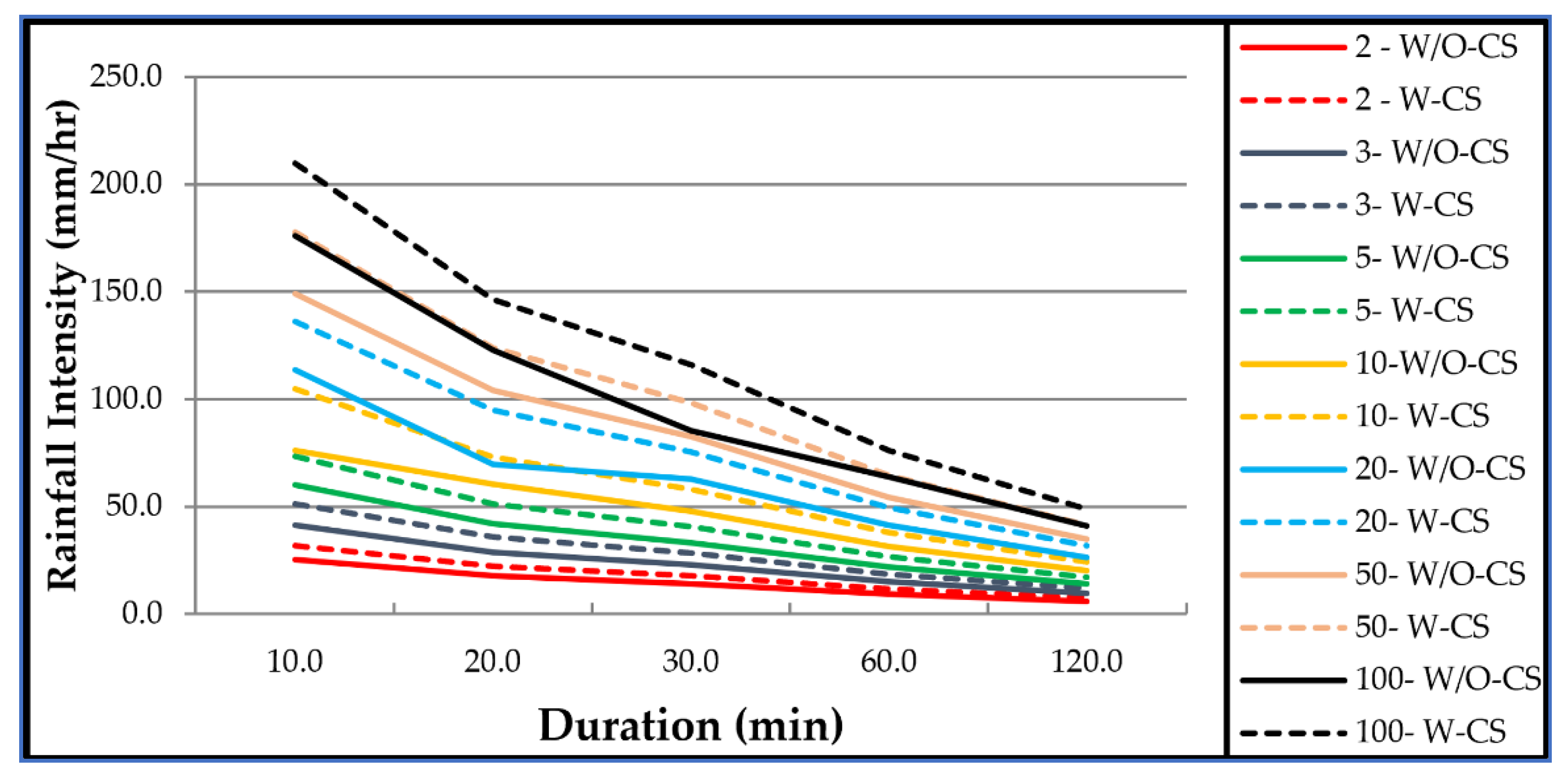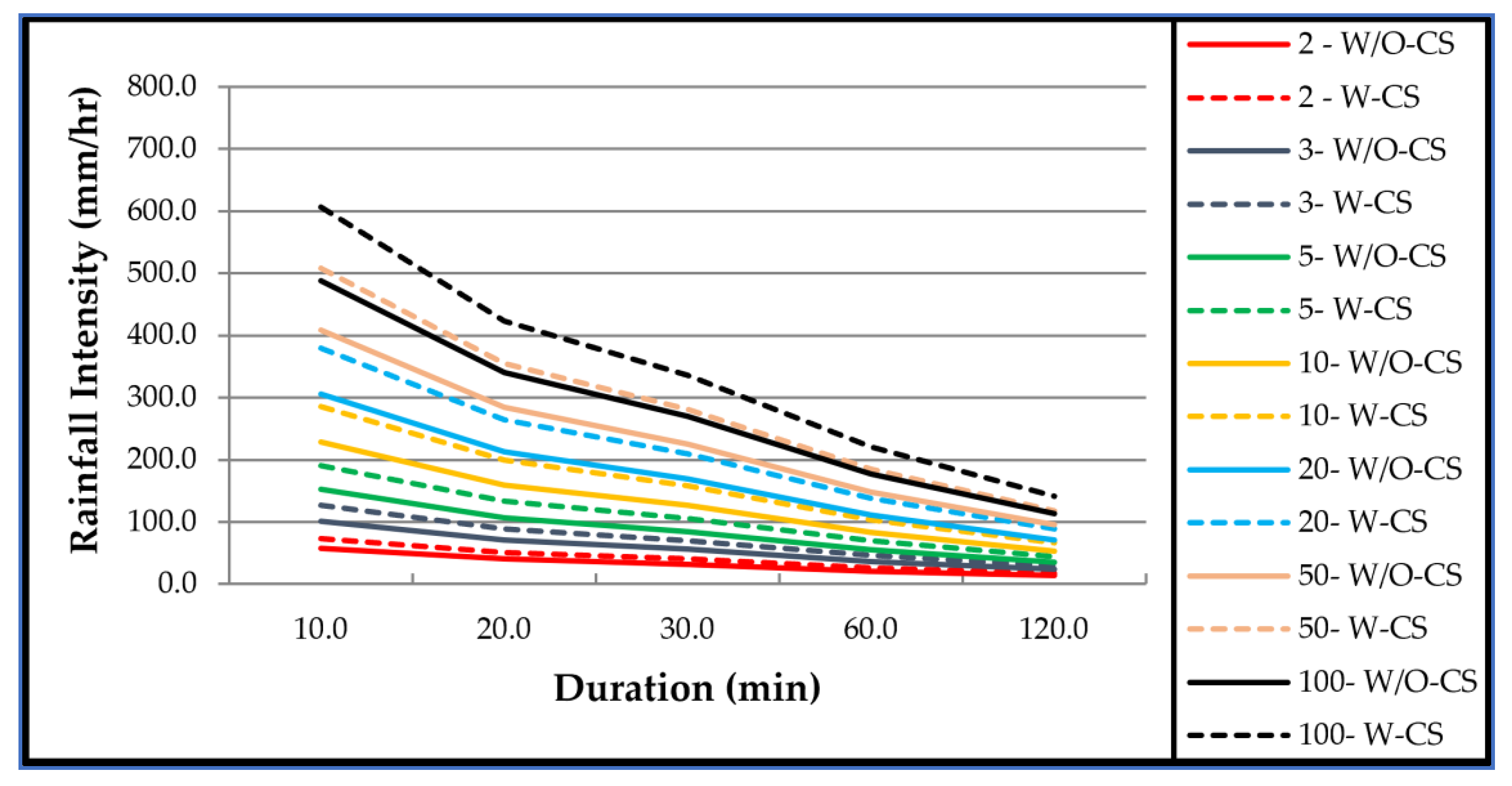1. Introduction
Addressing urban flood impacts requires a comprehensive understanding of the climate conditions at a specific region depending mainly on previous research and published meteorological data records. Sharjah city in the UAE has witnessed repetitive events of urban floods in the last three decades, especially during the rainy months that extend from December to March. The recent urban flood of January 2020 showed significant challenges to the city and impacted the daily life of the populace in all aspects. However, Sharjah city, similar to many cities in the Arabian Gulf region, is seeking to explore efficient solutions to this dilemma where previous studies are rare and meteorological data are hard to obtain.
Previous studies in the region, such as those conducted by Yilmaz et al. [
1] and Sherif et al. [
2], had discussed the impact of climate change on intensity-duration-frequency (IDF) curves. However, none had examined the impact of cloud-seeding missions on the (IDF) relationship for Sharjah city or other places as far as the authors are aware.
In the last decade, motivated by booming global cloud-seeding programs, the United Arab Emirates started operating cloud-seeding missions for additional rainwater to meet the rising water needs in the country. The first exploratory programs started in the 1990s and altered the quantity of precipitation released from clouds (Malik et al.) [
3]. Following the initial exploratory missions, the programs took off on a large scale in 2010 as an official policy of the government. This was inevitable for a very arid country with a normal average annual rainfall of less than 100 mm and high evaporation rates (Mazroui and Farrah) [
4], resulting in non-existent surface water and over-reliance on the non-renewable groundwater resources that have led to the depletion of aquifers.
As noted above, in 2010, the UAE began the cloud-seeding project officially, which registered success in developing rainstorms in the deserts of Dubai and Abu Dhabi (Kumar and Suzuki) [
5]. By 2016, the UAE reinforced its missions on cloud-seeding with approximately 100 flights per year carrying ionic compounds (such as sodium chloride) to seed the clouds. In 2018, the National Centre for Meteorology in the UAE revealed that the country executed 184 cloud-seeding operations as a consequence of which there was a 55 mm increase in annual rainfall the following year (Ćurić et al.) [
6].
The cloud-seeding process enhances the amount of rainfall of the storms. According to the National newspaper [
7], the amount of rainfall generated by cloud-seeding operations increases by 35 percent in clear weather conditions, which had been observed in several areas that share the border with Sharjah city in the first three months of 2020. The Ministry of Environment, Water, and Agriculture emphasized that the program targeted specific clouds to release the highest quantity of water. While the increased precipitation will benefit groundwater recharge, the increased runoff generated can overwhelm inappropriately sized drainage networks resulting in urban flooding (Al Hosari et al.) [
8].
Almazroui et al. [
9] explored the anticipated changes in temperature and precipitation in the near and far future over the Arabian Peninsula, which includes the UAE in the east. They noted that the amount of precipitation in the eastern region is minimal due to the hyper-arid climate, a situation that is unlikely to change much in the future. All this makes rainfall enhancement efforts such as the ongoing cloud-seeding programs extremely important for water security in the country.
In 2020, Dar Consultants [
10], an engineering consultancy firm, was commissioned by Dubai Municipality to develop a comprehensive solution for stormwater accumulation, conveyance, and proper discharge. The consultant highlighted several aspects to consider in dealing with the city’s urban floods, such as evaluating and updating stormwater network design criteria, including IDF curves, storm profiles, and the impact of the prevalent cloud-seeding on these aspects. However, Dar concluded that no specific data on the cloud-seeding effect on rainfall intensities had been discussed or presented. Therefore, it requires further review in later stages of rainfall analysis and requires much more time than the short period allocated to the current high-level study.
On the local level of Sharjah city, Yilmaz et al. [
1] conducted rainfall trend analysis using hourly data received from Sharjah International Airport to understand climate change effects on the intensity-frequency-duration variability in the city. The study succeeded in presenting a general methodology to update developed IDF curves and stressed the importance of longer rainfall data records to reduce the variability of estimated design intensities. Merabtene et al. [
11] assessed seasonal and annual rainfall trends and variability in Sharjah and found that the annual rainfall trend over Sharjah city is continuously decreasing.
Drainage networks are traditionally sized based on the adopted storm intensity as derived from the IDF function. The existing network of Sharjah city had been constructed in stages over the last forty years using intensities derived with pre-cloudseeding IDF functions as expected. Any increase in these intensities due to cloud-seeding will invalidate the existing designs with implications for the performance of the network (Adeloye and Rustum) [
12].
This paper will develop IDF functions for Sharjah city using hourly rainfall records from 1992 up to 2020 and thus quantify any impact that the cloud-seeding may have had on rainfall intensities. The paper also addresses the gap in the literature to discuss the impact of cloud-seeding operation on IDF functions.
2. Literature Review
In light of the increasing interest in hydrological studies in the region, researchers attempt to better understand the actual water resources situation throughout their valuable scientific papers related to Sharjah city and the UAE in general. The outcomes of these studies have helped to improve the understanding of the historical climatological characteristics of the country, including the development of applicable methodologies for designing locally relevant IDF curves. However, these existing tools, albeit useful, suffer from the limitation in which they were developed using relatively short data records for the pre-cloud seeding period that may not be relevant for the actually enhanced rainfall situations in the country. The significance of this paper is to address these two gaps and thus provide refined IDF functions that will form the basis of assessment of facilities for flood control and conveyance.
On the local level of Sharjah city, Yilmaz et al. [
1] conducted rainfall trend analysis using hourly data received from Sharjah International Airport’s station to understand the climate change effects on the intensity-duration-frequency variability in Sharjah city. Achieving the study’s intent focused on performing rainfall trend analysis for Sharjah city, UAE, and studying rainfall relationship by fitting heavy rainfall data to extreme value distributions. They found that the rainfall trends decreased for short duration storms, i.e., 1, 3, and even 6 h, whilst non-significant increasing rainfall trends were observed for long storm durations. Despite the study’s limitation in historical rainfall records, it updated Sharjah’s IDF relationships, which represents an essential contribution to local hydrological studies.
Merabtene et al. [
11] presented another significant paper to assess the seasonal and annual rainfall trends and variability in Sharjah city, to examine the impact of climate change on long historical rainfall records. They analyzed the recorded seasonal and annual rainfall at Sharjah International Airport for over 81 years, ranging from 1934 to 2014, using parametric and nonparametric statistical measures. They also used the mean annual rainfall recorded between 1966 and 2014 at Dubai airport to assess the seasonal and annual rainfall trends and variability in Sharjah. They concluded that the annual rainfall trend of Sharjah is notably decreasing over the study period, which reflects the impact of climate change on rainfall trends.
Sherif et al. [
2] presented a broader study to address the spatial and temporal characteristics of rainfall for the four climatic regions of the UAE: the East Coast, Mountainous area, Gravel Plains, and the Desert Foreland. They analyzed annual rainfall data from 42 rain gauge stations using various statistical methods and developed IDF relationships for each region. The paper demonstrated the inter-regional variability of rainfall characteristics in the UAE.
Aside from the previous local contributions, Ewea et al. [
13] derived the intensity-duration-frequency curves for the Kingdom of Saudi Arabia, an adjacent country, based on rainfall events measured at 28 meteorological stations distributed throughout the Kingdom, covering a period range from 20 to 28 years. The historical records included 2027 storms that vary between 10 min to 24 h in duration. The study recommended considering the effect of climate change on rainfall intensities by reviewing IDF curves regularly, which agrees with the previous effort of Elsebaie [
14] on Najran and Hafr Albatin at KSA.
In Kuwait, Aldosari et al. [
15] updated the IDF curves as part of efforts to address the recent flash floods affecting the country’s urban areas. They argued that the existing IDF curves of Kuwait are inappropriate because they were developed roughly three decades ago and cannot represent the current rainfall patterns in the country. They compared the updated and the existing IDF functions, which showed increasing intensities for most return periods at short durations. The focus of our current study is to unveil similar information for Sharjah city, which will improve the sizing of drainage facilities and reduce the incidence of flooding.
4. Results and Discussion
As explained in the methodology, rainfall data (24-h annual maximum rainfall depth) and mean values were derived for the three regions Sharjah, AL Dhaid, and Mleiha, over two significant periods. The first one started from 1 January 1992 up to 31 December 2009 without cloud seeding (W/O-CS) as shown in
Table 3, and the second period started from 1 January 2010 until 31 May 2020 with cloud seeding (W-CS). The rainfall data collected for the three regions without cloud-seeding (W/O-CS) and with cloud-seeding (W-CS) are shown in
Table 3 and
Table 4, respectively.
The results in
Table 3 illustrate the period from 1992 to 2009, which can be described as the very dry era, especially in Sharjah city and Al Dhaid, where the mean values for these two regions were relatively small (13.68 and 19.7 mm).
However, after implementing cloud-seeding operations, there was a significant increase in the values, as shown in
Table 4, where the mean values for the three regions had notably increased.
As illustrated in
Table 3 and
Table 4, the mean value for maximum daily rainfall depths for the Sharjah city region (W/O-CS) was 13.68 mm. After implementing cloud-seeding missions, the mean went up to 26.55 mm with an increment ratio of 94%.
Following the same steps in the Al Dhaid region, the mean value for maximum daily rainfall depths for the Al Dhaid region (W/O-CS) was 19.7 mm. However, after implementing cloud-seeding missions, the mean increased to 31.55 mm with an increment ratio of 60%. In Mleiha region, the mean value for maximum daily rainfall depths for (W/O-CS) was 49.42 mm, and after implementing cloud-seeding missions, the mean went up to 82.41 mm with an increment ratio of 67%.
Comparison of the data in
Table 3 and
Table 4 show a marked increase in mean rainfall following cloudseeding, with increases of 94% for Sharjah, 60% for Al Dhaid, and 67% for Mleiha (see
Table 5).
IDF Curves
The IDF curves were developed as described in the methodology section.
Table 6 and
Table 7, respectively, present the generated IDF values for the three cities over periods (5, 10, 20, 30, 60 min, and 120 min) against different return periods (2, 3, 5, 10, 20, 50, and 100 years) representing both cases without cloud-seeding (W/O-CS) and with cloud-seeding (W-CS). The values in
Table 7 clearly show the impact of cloud-seeding on intensity-duration-frequency curves where all values increased in the three cities. For example, in Sharjah city, the rainfall intensity over 10 min increased by 35.8% for a 2-year return period, 35.2%, and 34.8% for 10 and 100-years return periods.
Figure 2,
Figure 3 and
Figure 4 demonstrate the developed IDF curves for Sharjah, Al Dhaid, and Mleiha for both W/O-CS and W-CS cases over different return periods and illustrate the increase in rainfall intensity for all return periods W-CS. These figures clearly shows that the magnitude of the increase is a function of the return period, with more significant return periods exhibiting greater relative increases. The most significant increase in the values is found in the 100-year return period, and decreases gradually for smaller return periods.
The developed IDF functions for three different meteorological stations within the same geographical region of Sharjah (Sharjah airport, Al Dhaid, and Mleiha) before and after implementing cloud-seeding missions prove that cloud-seeding operations had led to an obvious increase in IDF values, i.e., the intensities of rainfall storms. In addition, the statistical analysis of the historical rainfall records confirmed that the mean of the maximum daily rainfall depths for each cloudseeded years had notably increased at the above meteorological stations compared to the pre-cloudseeding period.
Statistical analysis had provided a trustworthy indicator to make a judgment on the trend of historical rainfall records and can be used as a criterion to critic the impact of cloud-seeding on rainfall intensities. However, the comparison of the values of IDF curves before and after implanting the cloud-seeding missions had resolved the controversy related to the impacting of cloud-seeding on rainfall intensities by confirming that these missions had led to a clear and dramatic increase of rainfall storms intensity proved by the increase in the IDF curves values.
Another point to make is that cloud-seeding operations impact is not limited to the rainfall intensities but extends to create further implications on the local atmospheric aerosol burden. According to Farahat and Abuelgasim [
25], the cloud-seeding missions conducted in the UAE between January 2017 to March 2017 had evaluated to determine particulate matter (PM) variability before and after implementing these missions. The investigations involve 20 ground-PM stations, which shows a significant increase in PM
10 concentration during the above missioned period of cloud-seeding missions (Abuelgasim and Farahat) [
26]. Therefore, it is important to further investigate this matter in the local and regional atmosphere as part of the comprehensive assessment of cloud-seeding operations.
5. Conclusions
Cloud-seeding should not be considered only for precipitation, but it should be considered within the comprehensive context of urban development plans where drainage impact assessment is considered as an essential element of the overall development of the city. In addition, despite the economic and environmental importance of cloud-seeding missions through enhancing water resources security by, for example, more surface water availability and improved groundwater recharge, its impact will require additional investment and/or enhancement to the city’s infrastructure. Therefore, it is strongly recommended to regularly update the IDF information, especially in regions similar to the UAE that adopt cloud-seeding missions and evaluate their impact on other aspects of the city, such as the efficiency and performance of the storm drainage networks.
Another significant output of the study is extended reliable historical rainfall records for Sharjah city based on the self-organizing map approach (developed separately in another paper under review). The synthesized, hindcast rainfall records effectively provided additional 21 years of hourly rainfall data for the three stations, improving the efficacy and reliability of future design studies in the region. This is because the uncertainty associated with hydrological designs reduces as the length of the data record increases (Bell, Adeloye) [
24,
27]. Given the high expense of obtaining such high-frequency data by traditional measurement instruments, these additional data are a low-cost valuable resource for Sharjah City and the wider UAE.











